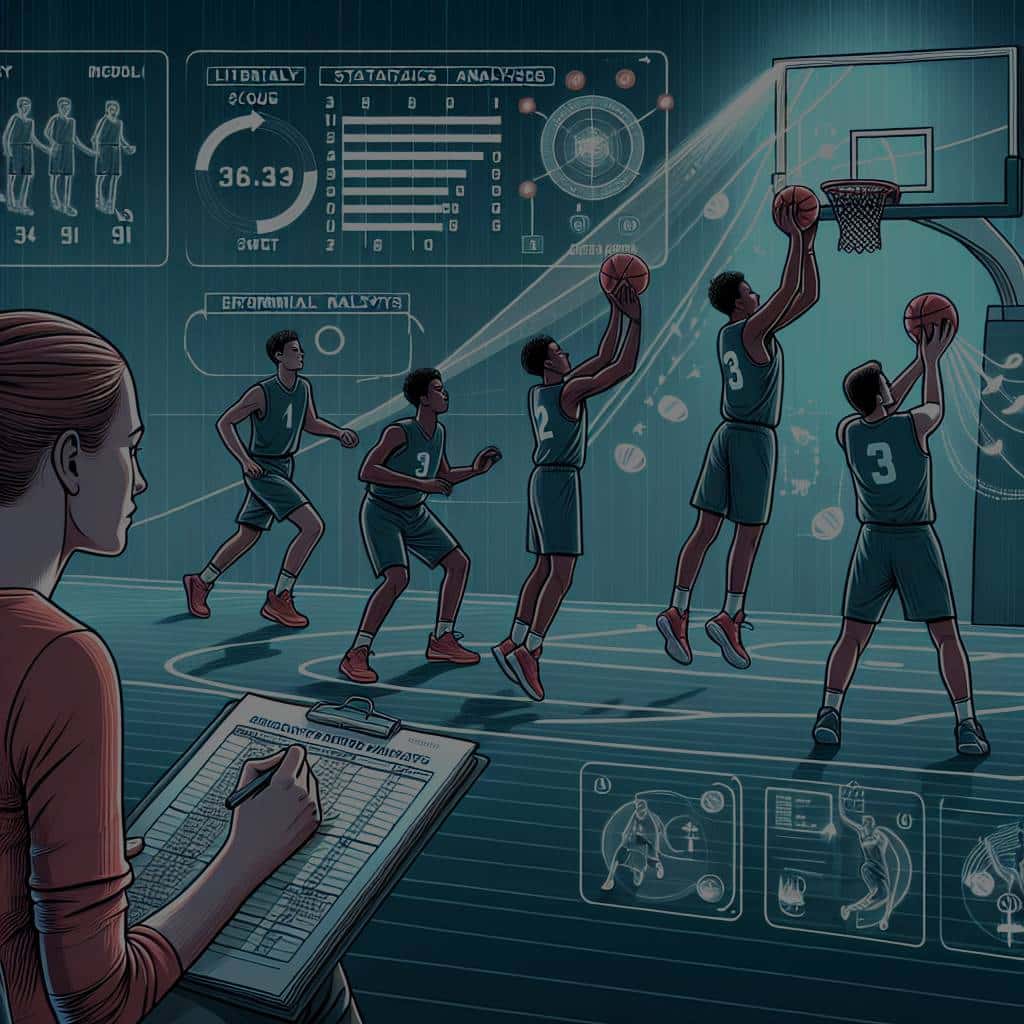As fans of college basketball, you’re undoubtedly aware of the sheer number of aspiring athletes who participate in college-level sports. Each year, countless promising players, from point guards to power forwards, step onto the hardwood with dreams of making it to the NBA. It’s the job of scouts to identify these talents and introduce them to the professional sporting world. But have you ever wondered how these scouts find such exceptional talents among the vast pool of players? This article dives into the advanced scouting methods used to detect talent in college basketball.
The Role of Data in Scouting
In the digital age, the process of scouting potential NBA talents has evolved significantly. Back in the day, scouts would rely on their intuition and experience, honed by years of watching games and players. However, with the advent of big data, the landscape has changed dramatically.
This might interest you : How Can Heart Rate Monitors Guide Training Intensity for Marathon Kayakers?
Data-driven scouting has become a crucial aspect of identifying talent in college basketball. Teams and scouts now rely on various data sources to gain insights about players’ performances and potential. These sources include Google, PubMed, Sci, and CrossRef, among others. These platforms offer vast amounts of data related to player performance, statistics, behavioral patterns, and historical performance trends.
For instance, Google and CrossRef provide comprehensive search capabilities, allowing scouts to seek out relevant articles, research papers, and reports about college basketball and individual players. On the other hand, PubMed and Sci offer access to scholarly articles, providing detailed analysis and research on player performance, injury risks, and potential talent indicators.
In parallel : What Strategies Enhance Recovery from Tendon Injuries in Rock Climbers?
By analyzing this data, scouts can make informed decisions about a player’s value and potential contribution to their team.
Performance Analysis in Scouting
Performance analysis forms the backbone of scouting in college basketball. It’s not just about how many points a player can score, though. Instead, it’s a comprehensive review of a player’s overall contribution to their team, their strengths, weaknesses, and potential for growth.
Scouts use performance data to objectively evaluate a player’s skills. This data includes player statistics such as points scored, rebounds, assists, steals, and blocks. But it also expands to more nuanced aspects of a player’s game, like their shooting accuracy, defensive skills, and ability to create opportunities for their teammates.
Scouts also consider a player’s performance under pressure and their consistency over time. Teams want athletes who can deliver in high-stakes situations and maintain their performance level throughout the season.
The Importance of Athlete Character in Scouting
While performance data and statistics are critical, they only paint part of the picture. An often overlooked aspect of scouting is evaluating an athlete’s character. Scouts assess a player’s attitude, work ethic, commitment, and how they interact with their teammates and coaches.
Character traits can be just as important as physical talent when it comes to a player’s success in the NBA. Players with a high level of commitment and a good work ethic are likely to continue improving their skills and performance. Similarly, players who have a positive attitude and good relationships with their teammates can contribute to a better team dynamic.
Scouts may gather information about a player’s character through interviews with the player, their coaches, and their teammates. They may also observe the player’s behavior during games and practices to get a sense of their personality and work ethic.
Use of Technology in Scouting
The use of advanced technology has revolutionized the way scouting is done in college basketball. Tools like video analysis software, wearable technology, and advanced data analytics platforms are now integral parts of the scouting process.
Video analysis software allows scouts to review a player’s games in detail. They can slow down the footage, focus on specific plays, and analyze individual performance aspects. This technology provides a more in-depth view of a player’s skills and abilities than watching a game in real-time.
Wearable technology helps scouts monitor a player’s physical condition and fitness levels. Devices can track an athlete’s heart rate, speed, distance covered, and other key performance indicators. This data provides valuable insights into a player’s endurance, strength, and overall physical abilities.
Data analytics platforms, on the other hand, help scouts make sense of the vast amounts of data available. These platforms can analyze and visualize data in a way that makes it easy to compare players and identify trends.
The Role of Scholarly Research in Scouting
Lastly, scholarly research plays an increasingly significant role in scouting. Scouts and teams are becoming more scientific in their approach, utilizing research from sports science, psychology, and data analytics to inform their decisions.
Scholars and researchers constantly study aspects of basketball performance, player development, and team dynamics. Their research can offer valuable insights into what makes a successful player or team. By keeping up-to-date with the latest research, scouts can stay ahead of the curve and make more informed decisions about player potential.
Scouts can access this research through databases like Google Scholar, PubMed, and CrossRef, which offer a wealth of academic articles on relevant topics. By integrating scholarly research into their scouting process, scouts can ensure they’re using the most reliable and up-to-date information when assessing talent.
As you can see, scouting in college basketball involves a lot more than watching games. It’s a complex process that requires expertise, technology, and a keen analytical mind. With advanced data analysis, performance metrics, character assessment, technological tools, and scholarly research, scouts are better equipped than ever to identify the next big NBA star.
Utilizing Machine Learning in Scouting
The advent of machine learning in the world of sports scouting has given scouts an incredibly valuable tool in their pursuit of identifying the next big star in college basketball. Machine learning enables computers to analyze vast amounts of data and identify patterns that humans might overlook.
Machine learning algorithms can be trained to analyze player statistics, physical measurements, and even elements of a player’s playing style. They can sift through years of data on thousands of players in an exceptionally short amount of time. This enables scouts to identify promising players who might otherwise have slipped through the cracks.
For example, a machine learning algorithm could analyze a player’s free throw percentage, three-point shooting accuracy, and tendency to commit fouls. It could then compare these statistics to those of successful NBA players, identifying similarities that suggest the college athlete might also have success at the professional level.
Machine learning can also analyze video footage, identifying subtle aspects of a player’s technique or style that might indicate their potential. For instance, it could identify a player’s ability to create shooting opportunities for themselves or their exceptional defensive positioning.
In short, machine learning can provide a level of analysis that goes beyond human capabilities. It enables scouts to make more informed and accurate decisions in their talent identification process.
The Future of Scouting in College Basketball
The future of scouting in college basketball promises to be even more data-driven and technologically advanced. With the continuous evolution of big data analytics, machine learning, wearable technology, and video analysis software, the process of scouting is becoming much more precise and comprehensive.
As the NBA continues to evolve and become even more competitive, teams will need to be more innovative in how they identify and develop talent. Scouting will continue to be vital in this process, and the use of advanced technology and data analytics will only become more critical.
Scholarly research will also continue to play a significant role in the scouting process. As more researchers delve into areas related to player performance, development, and team dynamics, their findings will further inform and enhance the scouting process.
The integration of databases like Google Scholar, PubMed, and CrossRef into the scouting process will facilitate access to up-to-date research, allowing scouts to stay abreast of the latest findings and trends.
Scouts will also need to continue developing their analytical skills. The ability to interpret and understand complex data will be crucial as more nuanced performance metrics become available.
In conclusion, the future of scouting in college basketball will rely heavily on the combination of traditional scouting wisdom and advanced technological tools. The most successful scouts will be those who can combine their intuitive understanding of the game with an ability to make sense of complex, data-driven insights. As the process continues to evolve, fans can look forward to witnessing an even higher level of play on the court as teams successfully identify and nurture the basketball stars of the future.











